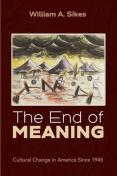BKMT READING GUIDES
The End of Meaning: Cultural Change in America Since 1945
by William A. Sikes
Paperback : 366 pages
0 club reading this now
0 members have read this book
Introduction
Towards the end of the twentieth century books proclaiming the “closing” of America’s mind, the “collapse” of her communities, and the “end” of her art, literature, education and more, began appearing with regularity. The underlying theme in all such works is the loss of those experiences that give our lives meaning. In The End of Meaning: Cultural Change in America Since 1945, readers learn to recognize these experiences, realize how prominent they were in the postwar period (c. 1945–65), understand the forces that have brought about their extraordinary decline (in our families and communities, universities and religious institutions, films and popular music, fine arts, labor and more) and realize the implications of this loss for our society and our humanity. In doing so the book provides a way of thinking about a vital subject—one which, despite its enormous importance, has never been examined in a broad and systematic way capable of generating real understanding, discussion and debate.
Editorial Review
No Editorial Review Currently AvailableExcerpt
Overview: Meaning and Culture When someone complains, “Things aren’t as good as they used to be,” someone else will often respond: “People have always said that. It doesn’t mean anything.” It is indeed likely that people have been saying that for a long time—certainly for generations, possibly for hundreds, if not thou- sands, of years. However, it doesn’t follow that it doesn’t mean anything. To the contrary, it may mean a great deal. While fond memories will inevitably distort the past, in the view of many older Americans, things were better in the postwar years (c. 1945– 65). I don’t mean they were physically or materially superior. Americans then had more modest medical care and shorter life spans than they do today. Women had much more limited opportunities, while minorities and those with disabilities were often relegated to the fringes of society— as was the LGBTQ community, when its members didn’t suffer outright persecution. The pace of life was slower in the postwar years, technology more primitive, and the pleasures of consumerism much more modest. Given all this (and more) it may seem strange that anyone would look fondly to the past. They are too old, we say. They have forgotten what it was like. But while the many changes over the decades have brought longer life spans, greater individual freedom, technological sophistication, un- told consumer riches and more, they have not brought more meaning. On the contrary, in the following pages we will find evidence that the vast majority of changes that typify the postmodern world (a world which, for us, began in the late sixties) exist in inverse relation to meaning in life. The notion of “meaning” employed in this book will be spelled out in detail in our first chapter. Suffice it to say that by the term I do not have in mind its usage in everyday discourse—meaning, as it were, with a small m. I am thinking rather of deeper experiences, like those that arise from close-knit families and communities, from having a sense of vocation or purpose in life, from falling in love, reveling in the glories of nature, listening to great music and the like. It is in these experiences of “connection”—to other people, or to larger ideas or powers—that a deep and lasting sense of meaning in life is to be found. Meaning like this is chiefly a function of culture, which provides its inhabitants with such ex- periences and teaches them to recognize their value—or fails in this vital task. Indeed, any culture that lacks the capacity to provide and enhance experiences like these is almost certainly on its last legs. If we wish to see where meaning flourishes, we might look to the Pueblo peoples of the American Southwest (like the Zuni and Hopi) as they still existed in the years between the two World Wars.1 Here the “connections” we have in mind were everywhere. They included: com- mon labor; intimate ties to nature; strong bonds to family and commu- nity; vital arts, crafts, stories, and songs (all of which gained meaning from their foundations in age-old values, styles and methods); a broader vision of life that embraced the wider universe and stretched back gen- erations; and a notion of life’s journey that gave meaning to each stage of individual existence—not only on earth, but beyond. At the heart of these cultures was religion. C. G. Jung, the founder of analytical psychology, tells a story from his travels in the American West in 1925 that dramatizes this. Jung had sought out a man named Moun- tain Lake, who was a leader of the Hopi nation and one of a group of old men known as the “Keepers of the Faith.” At the time, Pueblo religious practices were being harshly suppressed by the American government— a policy that took a turn for the better a few years later. Thus Mountain Lake was guarded in his conversations with Jung, and often vague regarding the deepest mysteries of his people’s faith. However, at one point in their conversation, Mountain Lake can no longer contain his confusion and anger. Why won’t the Americans leave us alone, he asks; don’t they know that what we do benefits the entire world? When Jung probes a bit further, Mountain Lake gestures to the sun: “After all,” he said, “we are a people who live on the roof of the world; we are the sons of father Sun, and with our religion we daily help our father to go across the sky. We do this not only for ourselves, but for the whole world. If we were to cease practicing our religion, in ten years the sun would no longer rise. Then it would be night forever.” Jung continues: I then realized on what the “dignity,” the tranquil composure of the individual Indian, was founded. It springs from his being a son of the sun; his life is cosmologically meaningful, for he helps the father and preserver of all life in his daily rise and descent. If we set against this our own self-justifications, the meaning of our own lives as it is formulated by our reason, we cannot help but see our poverty. Out of sheer envy we are obliged to smile at the Indians’ naiveté and to plume ourselves on our cleverness; for otherwise we would discover how impoverished and down at the heels we are.2 The vital point here is the extraordinary sense of meaning that comes from an existence that includes assisting the life-giving powers of the universe. Our technology may do wondrous things, but it has never enabled the sun to rise—and it never will. There is a steep price to be paid for such a life of meaning. Although the Pueblo, like all traditional peoples, have a relationship to nature that is not only meaningful but ecologically sound, it is one that discourages material advancement. Such a life also places severe limitations on the individuality and personal autonomy we regard as so essential today. Pueblo tradition puts significant restrictions on marriage, and the Pueblo divide labor according to patterns that are typical of small-scale societies (i.e., women usually work at home while men work abroad, clearing the land, hunting, trading and the like). The behavior of children is firmly controlled by elders, who will sometimes frighten a child into behaving by telling him he may be attacked by witches, or by bogeys who will spirit him away in a basket. Respect for elders is strictly enforced. Although customs differ somewhat among the tribes, Pueblo children may be expected to pause in play when an elder passes, to greet elders respectfully by a kinship term (never by name), and to take on a submissive posture (with arms behind their back) when waiting on them. The most characteristic behavioral strictures for Pueblo of all ages are demands for social solidarity and cooperation, which commonly come at the expense of individual freedom and initiative. The traditional Pueblo home offers very little privacy. Moving from towns is discour- aged, and those who must leave their home generally seek labor as nearby as possible. Disputes typically take place between groups rather than individuals, while labor within the community is often a collective activ- ity, according to the notion that all will at some point need the help of others. Community work includes hunting and gathering firewood, spin- ning wool and grinding corn, planting and gathering crops, and special projects, including care of the irrigation ditches that are vital to some of these communities. As we might imagine, these activities are rich in that social capital that adds enormously to meaning in life. In conjunction with religious ceremonies (which occupy entire weeks of the year) they are the bedrock of meaning-rich societies. In the Pueblo communities, members who show originality or initia- tive are often disparaged. It is the one who is discrete and group-oriented, rather than the outspoken or even the most talented, who is generally chosen for important positions in the community. Elsie Clews Parsons says of the Zuni that the man “who thirsts for power or knowledge, who wishes to be, as they scornfully phrase it, ‘a leader of his people,’ receives nothing but censure and will very likely be persecuted for sorcery.”3 This lack of self-assertion carries over into little daily rituals. In his autobiog- raphy, A Zuni Life, Virgil Wyaco notes how Indian men lightly touch flesh when shaking hands, and refuse to look in the other’s face, regarding a firm handshake and direct eye contact as aggressive actions. Wyaco adds that, in many contexts, even gentle questions may be considered aggres- sive, and that pointing is widely associated with witchcraft.4 Not only self-assertion but self-expression as we usually understand it is frowned upon. Creative endeavors like art, songs, or stories are ex- pected to follow time-honored patterns rather than take form as creative expressions of individual talent or point of view. An underlying sacred purpose is evident in all, instilling them with meaning. As Parsons ex- plains: “Poetry and song, dance music and steps, mask, figurine, fresco and ground painting, beautiful feather-work, weaving and embroidery, whatever else they are, also are measures to invoke and coerce, to gratify or pay, the Spirits.”5 In the Pueblo villages, age-old myths are told and reenacted in ritual, while (at least prior to the advent of TV) the old stories are passed on from generation to generation at evening in the home. The character of songs also remains the same. This is typical of traditional peoples generally, as Ananda Coomaraswamy has characterized them: “New songs, yes; but never new kinds of music, for these may destroy our whole civilization.”6 Coomaraswamy may not exaggerate. Writing as an old man at the end of the twentieth century, Wyaco cites the appearance of radio and TV—and especially the rock and roll music that became their staple—as the chief cause of the breakdown of Zuni culture in the fifties.7 In all this, the traditional Pueblo appear to be very different from us. And yet, their world is not so very different from the world of postwar America. Indeed, in many ways American culture then was closer to the Pueblo world than to our own. The biggest criticism of postwar Americans was that they had lost the spirit of individualism that had been so vital to the nation’s success. Beginning with The Lonely Crowd (1950),8 and proceeding through a number of both academic studies and popular films and novels, Ameri- cans of the era were depicted as a generation who took their cues from others rather than relying upon their own initiative. The many “yes men” in America’s corporations (popularized in Sloan Wilson’s 1955 novel, The Man in the Grey Flannel Suit) was the most obvious example of this. Many believed that men accustomed to taking orders during the war were now adopting the same approach in their work, politics and families—to the detriment of society. Women were no better. Popular culture of the day dictated that women marry young and assume the role of housewives, “smiling as they ran the new electric waxer over the spotless kitchen floor” in Betty Friedan’s memorable phrase.9 Critics seemed unable to understand that a generation that had recently suffered war and depriva- tion were content to take meaning where they found it. Close-knit communities and families were another salient feature of American society in the postwar years. In cities, ethnic communities were prominent, and, weather permitting, socializing took place long after dark on stoops or in popular establishments. America’s country- sides then had twice as many farms in a nation with half the population, leaving plenty of woods, fields and vacant lots for children to explore. Those living in the postwar housing developments were noted (and often criticized) for their strong sense of community. This was evident from the dozens of community organizations in the big developments (more than sixty each in Park Forest, Illinois, and Levittown, New York10) and by the willingness of neighbors to share important items like lawn mow- ers, silver, and china. Small towns then had town centers, with hotels, restaurants, churches, and movie theaters. Cousins generally lived close to cousins, neighbor knew neighbor, and grandparents tended to be available for advice and to pass on family history. Homes were small by today’s standards, and this, in conjunction with the baby boom, brought children closer together, while encouraging parenting by community. PTAs flourished, and both parents and schools stressed citizenship and getting along with others more than the athletic success and high test scores so valued today. Young people who attended colleges and universities in the period were expected to broaden their horizons by studying the major writings of Western civilization and by reading the classics of English literature (Shakespeare especially). It was a time when college students often took advantage of available cultural activities on campus, like guest speakers or concerts of classical music. Most of the young regarded the college years not simply as a time for fun and career preparation, but as a rare oppor- tunity to engage with those deeper issues that promised a greater sense of meaning in life. Such notions persisted into the late sixties, when some 86 percent of incoming college freshman said that “developing a meaningful philosophy of life” was either “essential” or “very important” to them.11 This is about twice the number who find meaning important today. Like the Pueblo, postwar Americans generally assigned some jobs to men and others to women. Labor then was not the socially disruptive force it so often is today. At a time when social stability was more im- portant than personal success, most men in small towns sought employ- ment in local businesses or became jacks of all trades, moving from one job to another as needs arose rather than uproot their families. Factory towns were relatively stable then, and those in industry found meaning in close-knit communities while taking pride in creating products that were expected to last. Big-city lawyers often regarded their work as a “calling,” and enjoyed close ties to clients, partners, and associates without “bill- able hours” being the bane it is today. Teachers were respected members of the community, and could expect support for both teaching methods and objectives without the disruptive classroom behavior and social and political controversy so widespread now. Service jobs had the great vir- tue of bringing people into close contact with their neighbors and fellow employees. Both the workweek and commute times were shorter in the postwar era, leaving more time for family. Parents raised children to- gether and socialized together at the popular bridge clubs, country clubs, PTAs, and churches. Family time in the fifties consisted of two common meals and some family radio listening or TV watching. With one radio or TV in the house, programs were generally chosen by consensus. At the time, profanity, graphic violence, and sexual content of any sort were forbidden (even the menacing notes of the Dragnet theme were enough to send some little children scurrying off to bed). Music was a popular radio and TV choice and, prior to the emergence of rock and roll, children and parents usually enjoyed the same songs. These tended to be romantic tunes, thereby conveying to the young an exalted vision of love that was elsewhere prevalent on the silver screen. Other popular tunes referenced America itself—from Patti Page’s “Old Cape Cod” to Perry Como’s “Dela- ware,” which mentions no fewer than fifteen states in its lyrics. Nat King Cole’s “Route 66” took listeners on an excursion through eleven cities located along the fabled highway. Such entertainment not only helped unite the country, but (along with the popular TV jingle, “See the U.S.A. in your Chevrolet”) encouraged Americans to get to know their nation in a way not possible before—nor after, when interstate highways and jets would render the American landscape a blur. One of the most remarkable features of postwar America was the ef- fort to provide ready access to serious culture. Popular periodicals of the day featured articles on prominent writers, classical musicians, and art- ists. This is not surprising given that, through the fifties, live performanc- es of classical music, opera, and drama had an important place on radio and TV. In the period, creators generally managed to reconcile their own individuality with a broader culture that featured the Bible, the classics, the nation’s history, and the distinctive character of its many regions. We see this, for example, in John Steinbeck and William Faulkner, Tennes- see Williams and Henry Miller, Carl Sandburg and Robert Frost. Dancer Martha Graham, as great a creative genius as any, looked to American myth and history in her works. So did the foremost American composer of the era, Aaron Copland. Their great collaboration, Appalachian Spring, is both a masterpiece and pure Americana.Discussion Questions
No discussion questions at this time.Book Club Recommendations
Recommended to book clubs by 0 of 0 members.
Book Club HQ to over 90,000+ book clubs and ready to welcome yours.
Get free weekly updates on top club picks, book giveaways, author events and more








